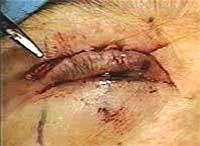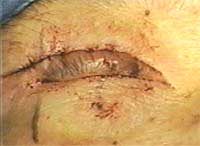Eyelid feature in Asian patients can lead to unrecognized entropion
Because the problem is mechanical and related to excess skin, surgery is the only option to correct the condition, a surgeon says.
HONOLULU, U.S.A. — Symptoms of foreign body sensation and irritation in Asian patients may be due to an inturning of the upper eyelid unique to this patient group, according to a surgeon here.
Jorge G. Camara, MD, chief of ophthalmology at St. Francis Medical Center, and colleagues at the center, described 53 consecutive patients with inturning of only the lateral portion of the upper eyelids in the December issue of Archives of Ophthalmology.
According to Dr. Camara, there have been previous reports of entropion of the lower eyelid, as well as one report of entropion of the full upper eyelid that occurred in one white patient and one black patient. However, he said, this report may be the first description in the literature of involutional lateral entropion of the upper eyelids.
“The purpose of the article was to make ophthalmologists aware of this finding. The first thing is to recognize it. I have seen patients who have been to other ophthalmologists and their condition was unrecognized,” Dr. Camara said in an interview with Ocular Surgery News.
“I think the reason this has been overlooked is because not much has been written on the Asian eyelid until relatively recently. Also, ironically, when one examines a patient who has this condition, and who is complaining of tearing and foreign body sensation, many times one actually lifts the eyelid to examine the eye … and misses the condition entirely. We can only diagnose what we look for, and we can only look for what we know,” Dr. Camara said.
 |
The fold of the patient's eyelid is usually obliterated by the condition. In the surgical correction of involutional lateral entropion of the upper eyelid, Dr. Camara first marks the area of the eyelid where the patient's fold would be. |
 |
An incision is made and excess skin is excised. The orbicularis muscle is then identified and stripped off the tarsal plate. |
 |
Bleeding is cauterized before sutures are placed. |
 |
Full thickness everting sutures are placed through the tarsal plate and out through the skin incision. This forces the lashes to rotate away from the globe. |
Involutional lateral entropion
The entity Dr. Camara and colleagues described is an entropion that occurs in only the lateral portion of the upper eyelid. He said the problem is a mechanical one that is due to the unique anatomy of the Asian eyelid.
| |||||||||||||||||||||||||||||||
In Asian eyes, the orbital septum fuses with the levator aponeurosis below the superior tarsal border. The tarsal plate is thinner than in the Caucasian eyelid, and excess skin causes the lid to invert.
“Because the orbital septum of Asian eyes fuses with the levator aponeurosis below the superior tarsal border, this inferior attachment results in two major things. If you look at Asian eyes, the preaponeurotic fat extends closer to the eyelid margin. The inferior extension of that orbital septum prevents the levator aponeurosis attachments from passing through the orbicularis muscle to the subcutaneous tissue. In other words, most Asian patients do not have a pronounced lid fold, unlike the Caucasian lid. They also have a shorter central tarsal height. All these factors contribute to this involutional lateral entropion in Asians,” Dr. Camara said.
According to the study, presence of foreign body sensation is the most common complaint patients have (85%), with the lateral aspect of the eyelid as the source of their discomfort. Other common complaints include tearing (77%), redness (34%), particularly in the lateral area of the conjunctiva, eye pain (26%) and itchiness of the lateral part of the canthal area (25%).
On examination, all patients in the study also exhibited trichiasis, lateral canthal tendon laxity and dermatochalasis.
Dr. Camara explained that the irritation develops as a result of the lateral aspect of the upper lid rubbing against the lower lid as the patient blinks. Over time, the patient develops an excoriation of the area. The condition usually manifests bilaterally, but can be asymmetric.
Surgical intervention
Because the problem is mechanical, surgery is the only way to correct the condition, Dr. Camara said.
In the study, 34 of 53 patients required surgical intervention. All were asymptomatic following the procedure.
 |
 |
Full thickness everting sutures are placed through the tarsal plate and out through the skin incision. This forces the lashes to rotate away from the globe. |
|
|
Dr. Camara initially treats patients with a combination antibiotic and steroid ointment to eliminate inflammation and irritation prior to surgery.
The fold is usually obliterated by the condition, so Dr. Camara marks the skin where the fold would be. An incision is then made, and the excess skin is excised. The orbicularis muscle is next identified and striped off the tarsal plate. Full-thickness sutures are placed through the tarsal plate and out through the skin incision so that the lashes rotate away from the globe.
For Your Information:Reference:
- Jorge G. Camara, MD, can be reached at St. Francis Medical Office Bldg., 2228 Liliha St. #407, Honolulu, HI 96817 U.S.A.; +(1) 808-533-0177; fax: +(1) 808-526-4871; e-mail: jordegcam@msn.com.
- Camara JG, Nguyen LT, et al. Involutional lateral entropion of the upper eyelids. Arch Ophthalmol. 2002; 120:1682-1684.

